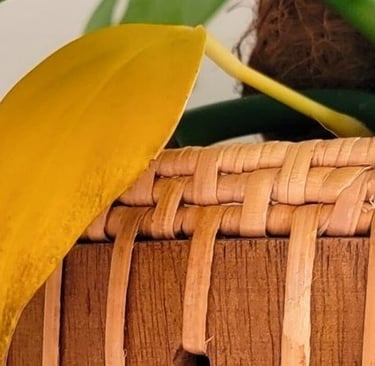Letting Go of Yellow Leaves: Lessons from My Houseplants


Oh no! You've spotted a yellow leaf on an otherwise healthy-looking plant. Is this cause for panic or perfectly normal?
When I noticed a yellow leaf at the base of my Dragon’s Tail philodendron this week, I didn't worry too much. Instead, I thought about what the dying leaf could teach us about resilience and adaptability.
Once a plant's leaf starts to turn yellow, there's no sense in trying to nurture it back to health. It's time to let it go.
So many factors can cause a plant's leaves to turn yellow. Here are just a few of them:
overwatering
underwatering
too much light
not enough light
overfertilization
underfertilization
other environmental factors
Whew! With that lengthy list, it's no wonder that yellow leaves happen sometimes. Leaf drop is completely normal. Old leaves turn yellow and die off.
Mandi Gubler from Happy Happy Houseplant has some great advice on this topic:
"I would recommend not removing damaged/yellowing leaves until you know the reason they are dying.
The main reason I don’t remove yellow leaves before the plant releases them is because I use them to watch for patterns. One yellow leaf is not a big deal and totally normal.
Multiples in a short period of time tell me something is going on. If I remove leaves when they start to yellow, how will I know if there is a pattern and how serious it is?"
Yellow leaves are easy to spot because they're quite a contrast from the green ones around them. This contrast is your signal to pay closer attention to the plant and get curious about what's going on with it.
🪴🪴🪴
Now, let’s plant this lesson in the soil of our lives:
Sometimes the things we try just don't work out, despite our best efforts.
Here are some examples:
You offered a new service in your business, but it never gained traction or brought you clients.
A client you onboarded and did some work for is just not a good fit for your business for whatever reason.
You downloaded an app because online reviews promised it would change your life, but it didn't work well for you.
The latest book everyone's talking about just wasn't your cup of tea so you didn't even finish it.
It's okay to delete something that isn't working well for you. You don't have to cut it off immediately after seeing "yellowing," but once the entire thing has changed "color," you can let it go.
I hereby give you permission to delete things from your life that aren't working for you. Instead, put your energy into pushing out new leaves or developing stronger roots.
To your success,
Julie from The Proofreader Greenhouse
P.S. If you'd like to read the other articles in The Watering Can, click here. 💦

